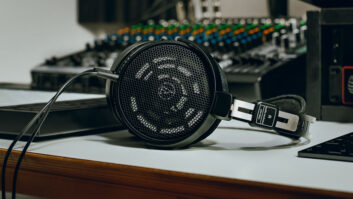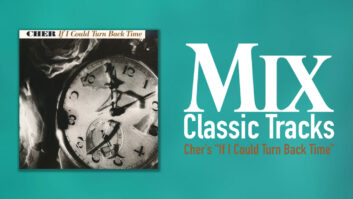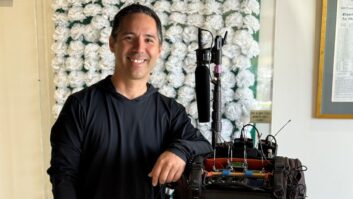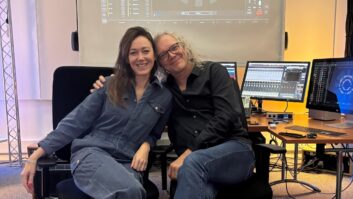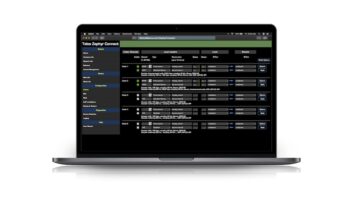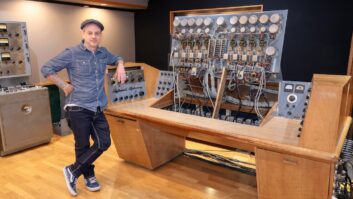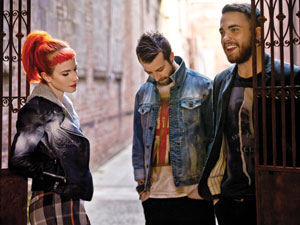
Hayley Williams, Jeremy Davis and Taylor York
Photo: Pamela Littky
In the three-and-a-half years since Paramore’s Brand New Eyes was released and sold more than a million copies worldwide, the Tennessee-based alt-pop/rock band has survived a difficult change in personnel with the departure of founding members Josh and Zac Farro, and the three remaining core musicians—singer Hayley Williams, guitarist Taylor York and bassist Jeremy Davis—have gone through some serious soul searching and musical exploration.
They’ve come out on the other side of their transitional period with a slammin’ new self-titled album, recorded in L.A. by engineer Carlos de la Garza and producer/musician Justin Meldal-Johnsen for the Fueled By Ramen label. Meldal-Johnsen—aka “JMJ”—is best known for his long stints with Beck and Nine Inch Nails, and as a session bassist (and keyboardist) for a wide range of acts, including the Dixie Chicks, Tori Amos, Garbage, Black-Eyed Peas, Jason Mraz, Macy Gray and Pink. But he’s also ventured into production, helming works by M83, Neon Trees, Tegan & Sara and others. JMJ worked on those last two with de La Garza—a producer/engineer who runs his own L.A. studio, called Music Friends.
Taylor York was the primary music writer on the new album—with Williams contributing lyrics and some melodic ideas—and York also worked up fairly elaborate demos for many songs in his home studio.
“Then I flew them out to L.A. to my studio [Dangerbird],” JMJ says, “and we spent a good amount of time dismantling their songs and getting into this sort of pre-production phase, which also turned into them doing some further writing on the spot, and me contributing to a little bit of writing, as well. After that we had another phase, and that was a full-on preproduction, which is when we brought in my Nine Inch Nails associate Ilan Rubin to play drums, and we spent about six days getting the songs to feel not only under their fingers in terms of the mechanics of what they were playing, but also to get a band feeling with Ilan incorporated. They gelled immediately, and six days later we had 17 songs ready to track.” (Rubin also played some piano on the album.)
The quartet laid down basics in Sunset Sound’s historic Studio 3—which is equipped with a custom API-DeMedio console. “We were mostly going for the drums,” de la Garza says, “but we had the guitar and bass playing along at the same time, and we tried to give it a live vibe by keeping as many of those bass and guitar takes as possible. Later, we went back to do the overdubs and tried to beat all the sounds we had, but there were a few that we kept that had a cool vibe that we were fine with. Hayley did scratch vocals on everything and she was amazing. I could have used any one of those takes to make the lead vocal on a track with minor editing.”
To capture Rubin’s drums, de la Garza used a Josephson e22S in combo with a Shure SM57 on top of the snare and a 57 under the snare; an AKG D 112 for some of the kick tracks, “but a lot of it is actually an AKG 441 and Subkick NS 10” for toms; Audio-Technica ATM25s on the top and 421s on the bottom; a Royer SF-24 stereo ribbon and a Sony C-24 as overheads; “and on the room we used some Cole 4038, [Neumann] U 67s, and on a couple of songs we used 251s for the far mics and a couple of Sony C-37s.”
Amps were well isolated from the drums and miked with a Sennheiser 421 and a 57 for York’s guitars and a 47 FET for Davis’ bass.
Once they had nailed solid drum tracks, the action shifted to JMJ’s well-equipped Dangerbird studio—located in a craftsman-style duplex—for guitar, bass and keyboard overdubs, plus all the vocals. The control room is in a former dining room, the machine room was a kitchen and the tracking room is two bedrooms combined into one space. The control boasts an API 1608 console and “synths wall-to-wall permanently patched for easy access,” JMJ says. “We spent a long time setting up the ideal situations for bass amps and guitar amps, a mic that was there to capture percussion and other bits, and a vocal station.” Williams’ lead vocals were cut using a Telefunken 251 into a Chandler mic pre, a Neve 1073 EQ, a Retro 176 compressor or an Inward Connections Vac Rac TSL-3 limiter.
There’s a lot of vocal, guitar and keyboard layering, and judicious use of strings (arranged by Roger Manning) and a choir—both recorded later at Sunset—that give the album a richness and depth, but JMJ and de la Garza were careful not to sacrifice energy and punch in the process. Ken Andrews (NIN, Beck, BRMC) mixed the album in his own studio.
“It was important to let the emotion shine throughout without it being pasteurized and edited into oblivion,” JMJ notes. While acknowledging a certain commercial sheen on a number of tracks, he says, “There are some moments on this record that are extraordinarily gritty. I wanted some raw nerves showing through.”

Producer Justin Meldal-Johnsen
And from the band’s perspective, “This album could not have been made with any other team,” comments Taylor York. “JMJ and Carlos opened up our eyes and ears to a different way of creating and how truly pleasing tones are created. We learned techniques and an intentionality that we will carry with us for the rest of our band’s existence.”
More from Paramore producer Justin Meldal-Johnsen (JMJ) and engineer Carlos de la Garza.
On how de la Garza and JMJ started working together.
dlG: We got together by happenstance originally. He was producing the last Neon Trees record and his studio, Dangerbird, had a flooding accident. They were in desperate need of a studio and the guys in the band, who I’d worked with—I engineered most of their first album—recommended me to Justin. I’d never met him before, but he came in and checked out the studio and from the day that he came in here, I started engineering for him on that. And then that led to doing two songs on Tegan & Sara’s record and then he said, there’s an opportunity for Paramore. We did one song initially with them— “Daydreaming”—and the band was very receptive to the process, so they hired him to do the entire record, which I engineered.
JMJ: Paramore reached out to me after hearing my work with M83, I believe. They were meeting with a list of producers, which is something a lot more artists are doing these days—they see who’s around and available and who might have certain insights into what they want to do. So, I was one of those guys and they kept narrowing it down and I made the final round, and before I knew it I was doing a song with them—“Daydreaming”— to see how the relationship went. After that, we got the green light from Atlantic and from Paramore management that they wanted to go for it.
On Sunset Sound.
dlG: It’s funky and a little old, but the staff is fantastic and the vibe there is so cool. It’s actually the first studio I ever recorded at as a player, in the mid-’90s. Smashing Pumpkins were there at the time, which was pretty exciting. But everyone’s been in there—Prince and Led Zeppelin and the Rolling Stones. The room sounds great, they have just about everything you would ever need, and having good people surrounding you is one of the most important thing to make sure a project is going to go smoothly. It gives you another layer of confidence.
JMJ: I’ve probably worked at Sunset more than any other place. It’s home to me and that particular room, Studio 3, is something I’m very, very familiar with. I know exactly what to do there. I feel like I can control it; it’s not a mystery of what I’m going to get.
On Ilan Rubin.
dlG: Ilan Rubin was amazing. He fit in immediately. They rehearsed at Swing House for a week to get the material down and I think it was sort of a collaborative process coming up with the drum parts for the record. Taylor, the guitar player, plays drums really well himself and had some specific ideas, and Justin did as well.
On the recording approach.
dlG: In terms of the general overall vibe of it, I think the band and Justin wanted to make it more unique-sounding than anything they’d done previously. He said, “I want to make a record different from the others you’ve made,” and they responded to that. You hear a lot more unique sounds in the layers than maybe you’ve heard on previous Paramore records. Which is not to knock those records—I love them, too.
JMJ: They wanted something new, and every band says that, but in this case it was true to the depths of their souls. And it wasn’t just new for the sake of new; it was new with an agenda—very specific bullet points; like a manifesto. So I decided to stand back from the rest of their catalog and approach it in a very new moment.
dlG: The way we tracked this record was kind of on a song-by-song basis. So, for a song like “Ain’t It Fun,” we had all the drums tracks. Then we tracked the bass, and the next day or two we tracked the guitars and then we’d do the vocals and then whatever remaining overdubs we had—synths or percussion or whatever. We occasionally would revisit a song to add a guitar solo or some other small thing later, but for the most part we did it one song at a time from start to finish.
That was a really fun way to do it, because you’re able to complete the picture of the whole thing sonically and see how things fit together. We refined our approach and our work flow, and we found the amps and sounds and microphones and setups that were really working, so by the time we got to the last few songs, we were on a quick workflow and knew exactly how we would move forward.
With all that layering, there must have been a lot of tracks on some songs.
dlG: There were. Some of the deeper ones are in the low 110s, for some of the biggest ones, but that’s including all the stereo keyboard tracks. If you have, say, five stereo keyboard tracks, things start to add up. And then there are the voices—doubles and harmonies on a lot of songs—and the string section, gospel choir… it adds up quickly.
Other outboard and plug-in choices.
dlG: On the analog side we used the board EQs and the board pre’s almost exclusively—either the DeMedio API [at Sunset] or JMJ’s [API] 1608. We used a lot of Distressor for guitar and bass compression. For keyboards, Justin loves running the synths through the A-Designs Ventura 500 series mic pre’s—he used a pair of those almost exclusively.
On the “commercial sheen”:
JMJ: I suppose some of that comes from the way I like to treat vocals, coupled with the way I like to layer synths and the way I like to do poptastic little gimmickry, because I get off on that stuff. But thankfully it was never a case where those things were done as some sort of desire to pander, or a requirement from up on high [i.e. a dem, and from the record company]. It’s just we wanted songs to have fun, poptastic, sometimes dance-y, sometimes very deliberately classic or fun references to certain ’70s or ’80s things, or certain recent pop conventions we dig. We weren’t afraid of that. It was very light-hearted and fun in that regard, in terms of those production values. Paramore can sing and play as well as any band that exists in the world, so anything that we did as window dressing was fun for us to listen to.
Who are some of your production influences?
JMJ: Well, I’ve spent a lot of time in the studio with Nigel Godrich, with Joe Chiccarelli and with Rick Rubin—all very different from each other. Those are three guys I would consider myself strongly influenced by. That said, because my experience as a musician is so varied, I’m really open to what the overall sonics will be when I produce, in that I don’t want to impose a signature or some conservative methodology or routine on it. I’m a chameleon by nature so I like to do it newly every time I do a record.
There are other producers and engineers who have influenced me and I couldn’t tell you exactly how, but I’m open to it. And certainly my experience with Trent [Reznor] and [Nine Inch] Nails affected me. But I separate those influences from being in the moment and trying to figure out what a record requires and what is singing to me in a subliminal way as being its core or it aesthetic heart.
I don’t think I have a very identifiable sound or style yet. A lot of what I did on the M83 album is quite personal, and that stuff—especially in keyboard world and the way I do programming and the way I do arpeggios and pads and lines—that’s a very constant through-line through Neon Trees, Tegan & Sara, Crystal Fighters, M83 and Paramore. But in terms of the overall sonic picture, I think I haven’t discovered what it is yet, and I’m really willing for that to continue to evolve. It’s also influenced by who is helping me mix the record. All five of those are different collaborations between myself and the mixer.
In this case, Ken Andrew is an old friend of mine who I have known almost longer than anyone in the music business. He’s part of the excellent modern rock tradition. I really enjoy the punch and tightness of his mixes. Here, though, it was the band and the label who decided on Ken, after a shoot-out, and he ended up being a perfect partner.
Was the band involved much in the production?
JMJ: Yes, they had some firm ideas about production. You know, people think of them as sort of modern rock punk-pop, but their influences run much wider and deeper than what their output has shown. And that’s part of what attracted me to the band in the first place. Among them they have a lot of taste that’s divergent yet similar amongst them. Jeremy, Taylor and Hayley all had unique ideas they brought to the table and usually there would be no dissension among the three of them. They work really well together and they’re all respectful of each other, which is always great to see.
